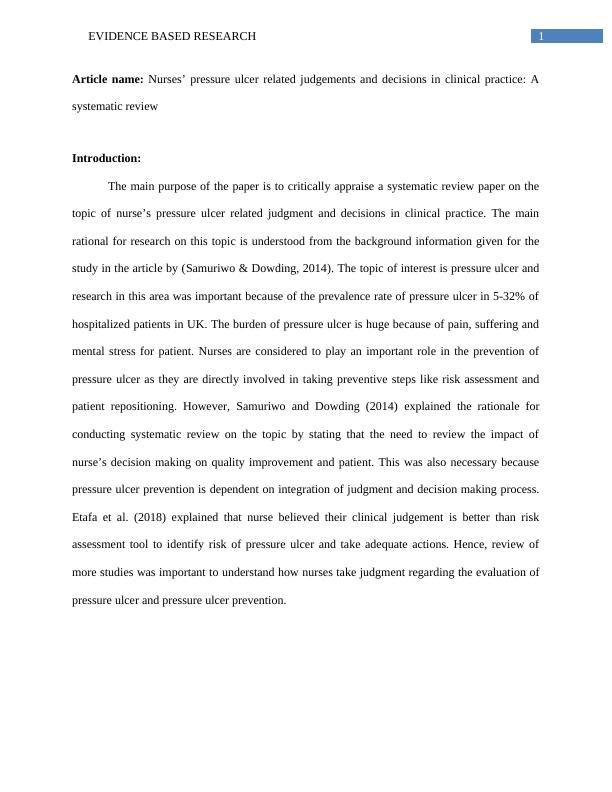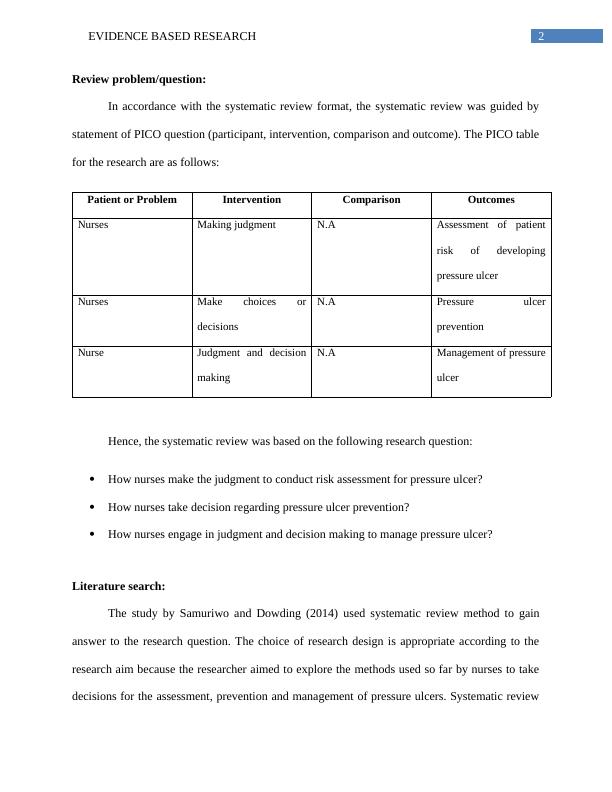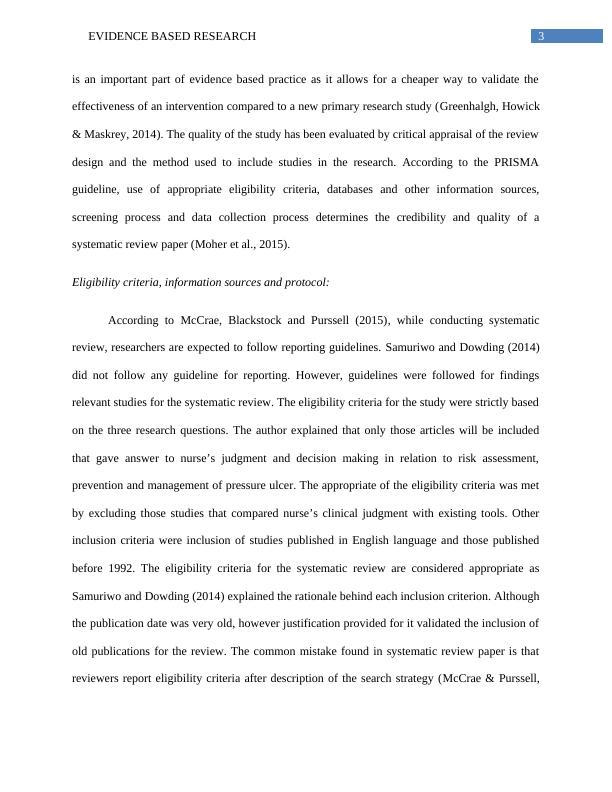Nurses’ pressure ulcer related judgements and decisions in clinical practice: A systematic review
Added on 2023-06-07
13 Pages3258 Words442 Views
Running head: EVIDENCE BASED RESEARCH
Evidence based research
Name of the student:
Name of the University:
Author’s note
Evidence based research
Name of the student:
Name of the University:
Author’s note

1EVIDENCE BASED RESEARCH
Article name: Nurses’ pressure ulcer related judgements and decisions in clinical practice: A
systematic review
Introduction:
The main purpose of the paper is to critically appraise a systematic review paper on the
topic of nurse’s pressure ulcer related judgment and decisions in clinical practice. The main
rational for research on this topic is understood from the background information given for the
study in the article by (Samuriwo & Dowding, 2014). The topic of interest is pressure ulcer and
research in this area was important because of the prevalence rate of pressure ulcer in 5-32% of
hospitalized patients in UK. The burden of pressure ulcer is huge because of pain, suffering and
mental stress for patient. Nurses are considered to play an important role in the prevention of
pressure ulcer as they are directly involved in taking preventive steps like risk assessment and
patient repositioning. However, Samuriwo and Dowding (2014) explained the rationale for
conducting systematic review on the topic by stating that the need to review the impact of
nurse’s decision making on quality improvement and patient. This was also necessary because
pressure ulcer prevention is dependent on integration of judgment and decision making process.
Etafa et al. (2018) explained that nurse believed their clinical judgement is better than risk
assessment tool to identify risk of pressure ulcer and take adequate actions. Hence, review of
more studies was important to understand how nurses take judgment regarding the evaluation of
pressure ulcer and pressure ulcer prevention.
Article name: Nurses’ pressure ulcer related judgements and decisions in clinical practice: A
systematic review
Introduction:
The main purpose of the paper is to critically appraise a systematic review paper on the
topic of nurse’s pressure ulcer related judgment and decisions in clinical practice. The main
rational for research on this topic is understood from the background information given for the
study in the article by (Samuriwo & Dowding, 2014). The topic of interest is pressure ulcer and
research in this area was important because of the prevalence rate of pressure ulcer in 5-32% of
hospitalized patients in UK. The burden of pressure ulcer is huge because of pain, suffering and
mental stress for patient. Nurses are considered to play an important role in the prevention of
pressure ulcer as they are directly involved in taking preventive steps like risk assessment and
patient repositioning. However, Samuriwo and Dowding (2014) explained the rationale for
conducting systematic review on the topic by stating that the need to review the impact of
nurse’s decision making on quality improvement and patient. This was also necessary because
pressure ulcer prevention is dependent on integration of judgment and decision making process.
Etafa et al. (2018) explained that nurse believed their clinical judgement is better than risk
assessment tool to identify risk of pressure ulcer and take adequate actions. Hence, review of
more studies was important to understand how nurses take judgment regarding the evaluation of
pressure ulcer and pressure ulcer prevention.

2EVIDENCE BASED RESEARCH
Review problem/question:
In accordance with the systematic review format, the systematic review was guided by
statement of PICO question (participant, intervention, comparison and outcome). The PICO table
for the research are as follows:
Patient or Problem Intervention Comparison Outcomes
Nurses Making judgment N.A Assessment of patient
risk of developing
pressure ulcer
Nurses Make choices or
decisions
N.A Pressure ulcer
prevention
Nurse Judgment and decision
making
N.A Management of pressure
ulcer
Hence, the systematic review was based on the following research question:
How nurses make the judgment to conduct risk assessment for pressure ulcer?
How nurses take decision regarding pressure ulcer prevention?
How nurses engage in judgment and decision making to manage pressure ulcer?
Literature search:
The study by Samuriwo and Dowding (2014) used systematic review method to gain
answer to the research question. The choice of research design is appropriate according to the
research aim because the researcher aimed to explore the methods used so far by nurses to take
decisions for the assessment, prevention and management of pressure ulcers. Systematic review
Review problem/question:
In accordance with the systematic review format, the systematic review was guided by
statement of PICO question (participant, intervention, comparison and outcome). The PICO table
for the research are as follows:
Patient or Problem Intervention Comparison Outcomes
Nurses Making judgment N.A Assessment of patient
risk of developing
pressure ulcer
Nurses Make choices or
decisions
N.A Pressure ulcer
prevention
Nurse Judgment and decision
making
N.A Management of pressure
ulcer
Hence, the systematic review was based on the following research question:
How nurses make the judgment to conduct risk assessment for pressure ulcer?
How nurses take decision regarding pressure ulcer prevention?
How nurses engage in judgment and decision making to manage pressure ulcer?
Literature search:
The study by Samuriwo and Dowding (2014) used systematic review method to gain
answer to the research question. The choice of research design is appropriate according to the
research aim because the researcher aimed to explore the methods used so far by nurses to take
decisions for the assessment, prevention and management of pressure ulcers. Systematic review

3EVIDENCE BASED RESEARCH
is an important part of evidence based practice as it allows for a cheaper way to validate the
effectiveness of an intervention compared to a new primary research study (Greenhalgh, Howick
& Maskrey, 2014). The quality of the study has been evaluated by critical appraisal of the review
design and the method used to include studies in the research. According to the PRISMA
guideline, use of appropriate eligibility criteria, databases and other information sources,
screening process and data collection process determines the credibility and quality of a
systematic review paper (Moher et al., 2015).
Eligibility criteria, information sources and protocol:
According to McCrae, Blackstock and Purssell (2015), while conducting systematic
review, researchers are expected to follow reporting guidelines. Samuriwo and Dowding (2014)
did not follow any guideline for reporting. However, guidelines were followed for findings
relevant studies for the systematic review. The eligibility criteria for the study were strictly based
on the three research questions. The author explained that only those articles will be included
that gave answer to nurse’s judgment and decision making in relation to risk assessment,
prevention and management of pressure ulcer. The appropriate of the eligibility criteria was met
by excluding those studies that compared nurse’s clinical judgment with existing tools. Other
inclusion criteria were inclusion of studies published in English language and those published
before 1992. The eligibility criteria for the systematic review are considered appropriate as
Samuriwo and Dowding (2014) explained the rationale behind each inclusion criterion. Although
the publication date was very old, however justification provided for it validated the inclusion of
old publications for the review. The common mistake found in systematic review paper is that
reviewers report eligibility criteria after description of the search strategy (McCrae & Purssell,
is an important part of evidence based practice as it allows for a cheaper way to validate the
effectiveness of an intervention compared to a new primary research study (Greenhalgh, Howick
& Maskrey, 2014). The quality of the study has been evaluated by critical appraisal of the review
design and the method used to include studies in the research. According to the PRISMA
guideline, use of appropriate eligibility criteria, databases and other information sources,
screening process and data collection process determines the credibility and quality of a
systematic review paper (Moher et al., 2015).
Eligibility criteria, information sources and protocol:
According to McCrae, Blackstock and Purssell (2015), while conducting systematic
review, researchers are expected to follow reporting guidelines. Samuriwo and Dowding (2014)
did not follow any guideline for reporting. However, guidelines were followed for findings
relevant studies for the systematic review. The eligibility criteria for the study were strictly based
on the three research questions. The author explained that only those articles will be included
that gave answer to nurse’s judgment and decision making in relation to risk assessment,
prevention and management of pressure ulcer. The appropriate of the eligibility criteria was met
by excluding those studies that compared nurse’s clinical judgment with existing tools. Other
inclusion criteria were inclusion of studies published in English language and those published
before 1992. The eligibility criteria for the systematic review are considered appropriate as
Samuriwo and Dowding (2014) explained the rationale behind each inclusion criterion. Although
the publication date was very old, however justification provided for it validated the inclusion of
old publications for the review. The common mistake found in systematic review paper is that
reviewers report eligibility criteria after description of the search strategy (McCrae & Purssell,

End of preview
Want to access all the pages? Upload your documents or become a member.
Related Documents
HLTEN514B - Apply research skillslg...
|14
|2921
|162
Evidence Based Practice: Preventing Hospital Acquired Pressure Ulcerslg...
|12
|3316
|1
Pressure Ulcers in Diabeteslg...
|8
|1069
|420
Evidence-Based Nursing Researchlg...
|19
|4280
|466
Evidence-Based Practice for Repositioning in Pressure Ulcer Preventionlg...
|10
|3287
|70
Preventing Pressure Injuries in Bethe Bound Patients Using Evidence Based Nursing Researchlg...
|8
|1680
|475
